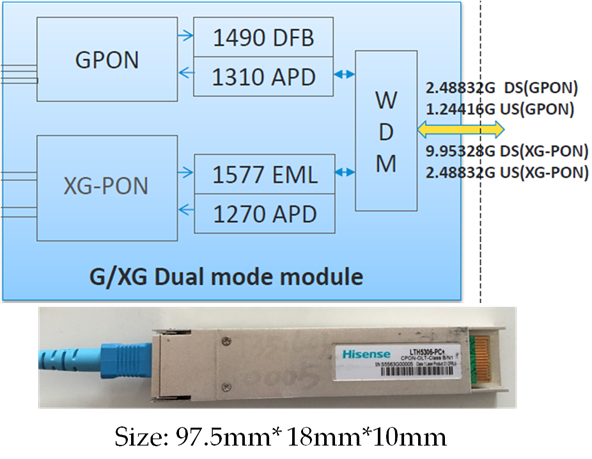In all honesty, at this time I do not think we need to get bogged with discussions on line card density. It would be valuable to discuss it once we have more details about the wavelength plan, as well as the system level complexity to know whether it even makes sense to consider certain migration scenarios.
Today, we perform upgrades by replacement of line cards and as it has been mentioned before many times, line cards that are retired from one location are reused elsewhere where services are lit up. The effective active life of such cards is very long (for some products, 10 years or longer is not surprising). I’d rather we did not limit the implementation options and leave vendors to do what they do best – innovate in their platforms rather than try to find a solution for all problems.
Regards
![]()
Marek Hajduczenia, PhD | Network Architect, Principal Engineer
4145 S. Falkenburg Rd | Riverview Fl 33578
================================
CCNP CSCO12874393

From: Liudekun [mailto:liudekun@xxxxxxxxxx]
Sent: Tuesday, June 28, 2016 7:32 PM
To: STDS-802-3-NGEPON@xxxxxxxxxxxxxxxxx
Subject: Re: [802.3_NGEPON] Presentations for the call tomorow
Hi Glen:
Thanks for your explanation. I get it.
I agree it is not an impossible thing to have a common interface and size for 25G and 100G optics, especially if we do some redundant design for 25G.
But it’s also not a high probability thing which will be happen. (I would like to say it’s more close to unlikely ).
During the upgrade GPON to XG-PON, which was hotly discussed in FSAN in the past half years, some operators are highly interest on a comb module of GPON&XG-PON (A module with both GPON and XG-PON OLT module, two transmitter, two receiver and a mux/demux) , it has been proved by the module vendors it will increase the size , and also bring a lot of challenging on demux isolation (there is only 10nm spacing between GPON and XG-PON upstream)
For 100G EPON, the channel spacing may be even smaller than 10nm, more channels and more high speed transceivers , so it will be even challenging .
To all the operators with interest, if 100G optics will deem to with bigger size than 25G (so the ports density in one board will be lower), which means you may need to increase the OLT slots when upgrade, do we need to consider the pay as you grow deployment in OLT ?

GPON&XG-PON dual mode module, it’s a prolonged XFP, while a single XG-PON module can be SFP format.
From: Glen Kramer [mailto:000006d1020766de-dmarc-request@xxxxxxxx]
Sent: Wednesday, June 29, 2016 1:57 AM
To: STDS-802-3-NGEPON@xxxxxxxxxxxxxxxxx
Subject: Re: [802.3_NGEPON] Presentations for the call tomorow
Hi Dekun,
Yes, to upgrade from one generation to another by replacing just the optics, I assumed that the optical module form factors and the electrical interfaces should be the same in both generations. I think 50G and 100G OLT ports are likely to use QSFP28.
On the ONU side, I am not sure pluggable optics will be common, so ONU are more likely to be replaced.
I didn't know that it was possible to have a dual-form-factor cage, as Marek mentioned.
Glen
On Tue, Jun 28, 2016 at 4:37 AM, Marek Hajduczenia <marek.hajduczenia@xxxxxxxxx> wrote:
It is not impossible to design a cage that would accept both modules. Additionally, we do not know what happens in terms of optical module design in the future and a brand new format could be designed to accommodate multi-rate optics for NG-EPON. I would not discard the general notion that Glen presented on the grounds of today's availability of optical modules and existing designs.
Another point to make, something that I forgot to mention on the call, is that from an operator's perspective, replacement of the whole ONU and replacement of an optical module are very similar in terms of the end expense - expenses related with the truck roll, customer outage, scheduling, etc. are typically much higher than the cost of new equipment.
Regards
Marek
On Tue, Jun 28, 2016 at 6:29 AM, Liudekun <liudekun@xxxxxxxxxx> wrote:
Dear Glen:
I didn’t attend the last telephone meeting due to I was in another meeting (the time is also difficult for me usually), I have a question on your contributions when I review them.
In the two contributions, there are several places mention the upgrade by “replacing the optical module” (such as from 25G OLT to 100G OLT)
Have you made an assumption that the 25Gb/s optical modules are with the same size and PINs layout with that of 50Gb/s and 100G optical modules ?
Only with this precondition, a 25G module is able to be replaced by a 100G module. But at the most probable case, 100G module should have more PINs than 25G, the size of 100G will also be larger than 25G.
If without this assumption, then upgrade by “ replacing optical module” will be not feasible.
I wonder if my understanding is correct.
Best regards
Dekun Liu
____________________________________________________
Advanced Access Technologies Dept. 网络研究接入技术部
Huawei Technologies Co., Ltd. 华为技术有限公司![]()
Phone: +86 027-59267217 Email: liudekun@xxxxxxxxxx
湖北武汉市关山一路光谷软件园A7-9 邮编:430074
Huawei Technologies Co., Ltd.
A7-9 Wuhan Optical Valley Software Park,Guan Shan Road,Wuhan,Hubei, P.R.China
From: Glen Kramer [mailto:000006d1020766de-dmarc-request@xxxxxxxx]
Sent: Thursday, June 23, 2016 6:29 AM
To: STDS-802-3-NGEPON@xxxxxxxxxxxxxxxxx
Subject: [802.3_NGEPON] Presentations for the call tomorow
All,
At some point during the last meeting, the conversation turned to whether a 100G device (OLT or ONU) with some channels disabled was still a 100G device or a 25G/50G device and whether such device would satisfy our objectives. I remember Frank's remark that we need to have a discussion on the 100G-EPON nomenclature. The first attached presentation (kramer_3ca_1_0616_configurations_2.pdf) is an attempt to start this discussion.
The second presentation (kramer_3ca_1_0616_upgrades.pdf) looks at various OLT and ONU upgrade scenarios and tries to answer a question whether keeping 25G line card and adding a separate 50G/100G line card is better or worse than just replacing the 25G line card with 50G/100G line card.
Looking forward to our call tomorrow.
Glen
